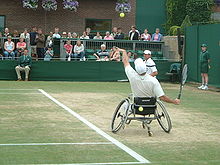The Grand Slam in tennis is the achievement of winning all four major championships in one discipline in a calendar year. In doubles, a team may accomplish the Grand Slam playing together or a player may achieve it with different partners. Winning all four major championships consecutively but not within the same calendar year is referred to as a "non-calendar-year Grand Slam", while winning the four majors at any point during the course of a career is known as a "Career Grand Slam".

Esther Mary Vergeer is a Dutch former professional wheelchair tennis player. Vergeer won 42 major titles, 23 year-end championships, and seven Paralympic gold medals. She was the world No. 1 in women's wheelchair singles from 1999 to her retirement in February 2013. Vergeer went undefeated in singles for ten straight years, ending her career on a winning streak of 470 matches. She has often been named the most dominant player in professional sports.

Shingo Kunieda is a Japanese former wheelchair tennis player. With four Paralympic gold medals, 28 major singles titles – an all-time record in singles of any tennis discipline – and 50 major titles overall, Kunieda is widely considered the greatest male wheelchair player of all time.

David Wagner is an American wheelchair tennis player. Paralyzed from the mid-chest down and with thirty percent function in his hands, he competes in the quad division. He plays by taping the tennis racket to his hand. He is currently ranked number three in the world in singles and number two in doubles.
Korie Homan is a Dutch former wheelchair tennis player. Homan won the gold medal in women's doubles at the 2008 Paralympics. In 2009, she completed the doubles Grand Slam by winning the Australian, French, Wimbledon and US titles with Esther Vergeer. In addition Homan has also had individual success in Grand Slams when she won the 2010 Australian Open title. Homan is a two-time Masters doubles champion and a former world number one.

Stéphane Houdet is a French wheelchair tennis player. Houdet is a former singles and doubles world number one. In 2014, he became the first man in history to complete the calendar-year Grand Slam in men's wheelchair doubles.

Ulrikke Pia Eikeri is a Norwegian professional tennis player. On 1 January 2024, she peaked at No. 37 in the WTA doubles rankings. She reached a best singles ranking of world No. 206 on 16 April 2018.

Jiske Griffioen is a Dutch professional wheelchair tennis player. Griffioen is a 20-time major champion, Paralympic gold medalist, seven-time Masters champion, and a former world No. 1. Alongside Aniek van Koot, Griffioen completed the Grand Slam in doubles in 2013. In singles, Griffioen is a three-time Masters champion, Paralympic gold medalist, four-time major champion, and a former world No. 1.
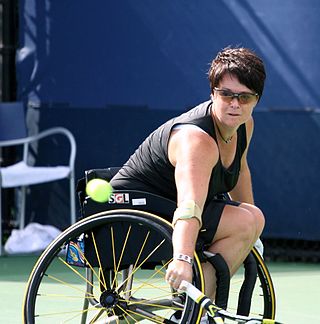
Sharon Walraven is a Dutch wheelchair tennis player. She became paraplegic at age 23 after complications following a fall while she was ice-skating. She has won seven Grand Slams doubles titles partnering compatriot Esther Vergeer. At the 2008 Paralympics in Beijing she won the gold medal in the women's doubles competition. At the 2000 Paralympics in Sydney she won a silver medal in the women's singles competition. Walraven has a highest ranking of No.2 in singles and No.1 in doubles.

Aniek van Koot is a Dutch wheelchair tennis player who is a former world No. 1 in both singles and doubles.
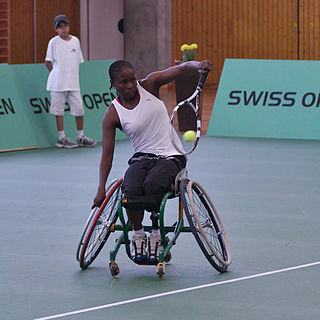
Kgothatso Montjane is a South African wheelchair tennis player. In 2018, she became the first black South African woman to compete at Wimbledon.

Sabine Ellerbrock is a former German wheelchair tennis player. Ellerbrock is the 2013 French Grand Slam champion in Wheelchair Women's Singles.

Yui Kamiji is a Japanese professional wheelchair tennis player. She has won 28 major titles, as well as a Paralympic silver and bronze medal in singles and doubles, respectively, at the 2020 Tokyo Paralympics. She also won a bronze medal in singles at the 2016 Rio Paralympics.
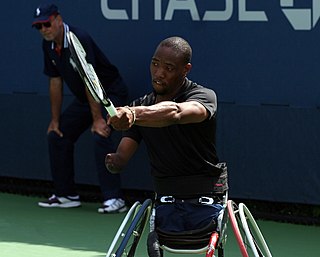
Lucas Sithole is a South African wheelchair tennis player. He plays in the Quad division of the sport. Sithole is the 2013 US Open wheelchair tennis quad champion. He also won the 2016 Australian Open Grand Slam in doubles, partnering David Wagner.
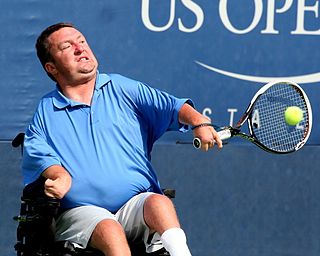
Nicholas Taylor is an American wheelchair tennis player. Nick started playing tennis at the age of 14. He has played 5 times in the Australian Open and 7 times in the US Open (tennis). He has a total of 11 grand slam quad doubles titles, all of them won with partner David Wagner. Taylor and Wagner are the most successful partnership to ever play at the UNIQLO Wheelchair Doubles Masters. They have won the title 11 times as of November 2018.

Diede de Groot is a Dutch professional wheelchair tennis player who is the current world No. 1 in both singles and doubles.
2019 French Open was a major tennis tournament played on outdoor clay courts. It was held at the Stade Roland Garros in Paris, France, from 26 May to 9 June, comprising singles, doubles and mixed doubles play. Junior and wheelchair tournaments were also scheduled. Rafael Nadal was the two-time defending champion in men's singles and won his record 12th French Open singles title. Simona Halep was the defending champion in women's singles, but lost in the quarterfinals; the title was won by Ashleigh Barty.

